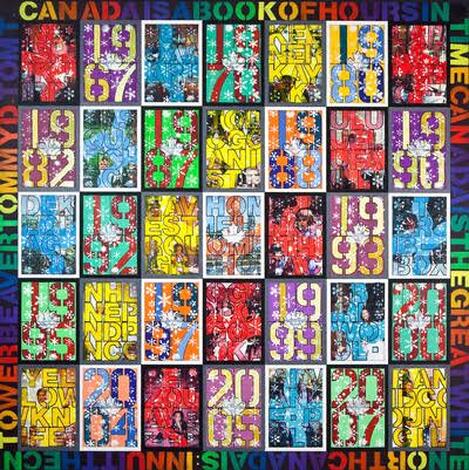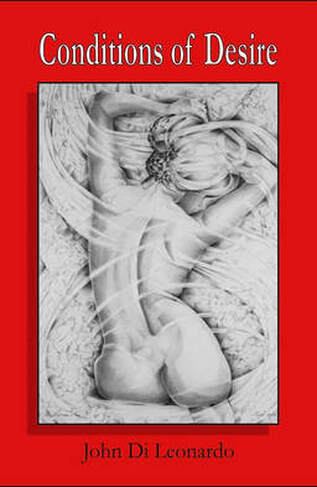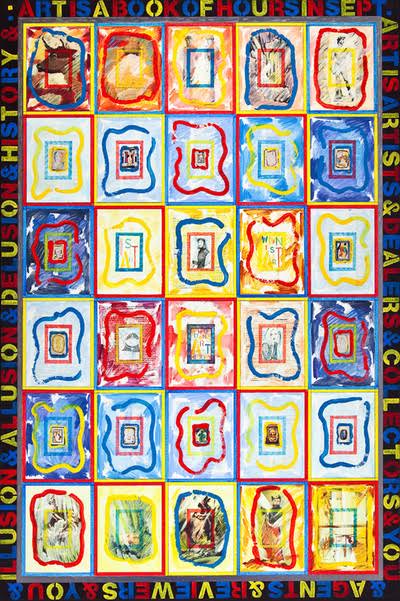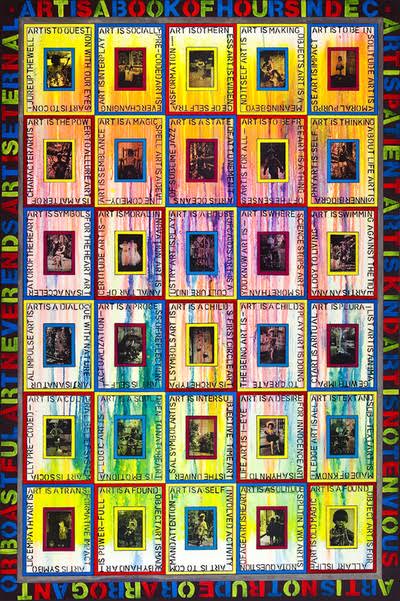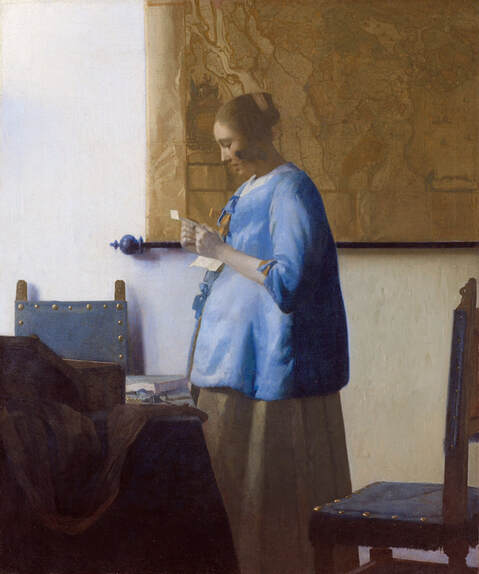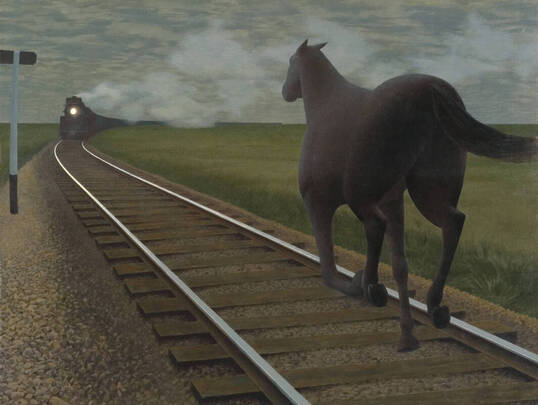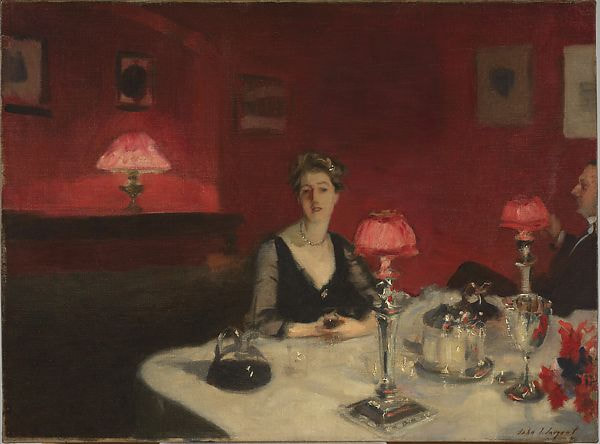|
The Ekphrastic Review is delighted to chat with Canadian artist and ekphrastic poet John Di Leonardo. He will also be a guest editor for one of our upcoming challenges! The Ekphrastic Review: The first thing I notice about your visual artwork is that we share an attraction towards words, letters, and numbers as a natural aspect of our subject matter. Can you comment on how and why language and letters play such an important role in your paintings? Words, letters and numbers have a long relationship in the history of eastern and western art, and have always been a natural aspect of visual expression. We see this ekphrastic connection in Egyptian tombs, Greek vases, Roman triumphal arches, medieval manuscripts, up to postmodern/conceptual art. We are so used to reading for meaning that we tend to forget that each letter and number is a beautiful shape in and of itself especially if we look at the history of typography. I enjoy the aesthetic dimension of a single letter, its shape, negative spaces created, the composition of each word. Visual artists have used letters not only to transmit Feminist ideology or protest as seen in the works by the Guerrilla Girls, or Barbra Kruger, but also philosophical ideas, as in Rene Magritte’s work Ceci n’est pas une pipe. (This is not a pipe.) We also see words as elemental shapes in paintings and collages by Picasso and many other contemporary visual artists. One of my favourite is John Baldassari’s work, I Will Not Make Any More Boring Art. Baldessari repeats the same phrase over and over again, good advice for any serious artist. Conversely, the history of ekphrastic poetry, words embracing art, is also a very long one. An early example where the sound of poetry embraces the silence of art can be seen when Homer describes the blacksmith god Hephaestus forging the shield of Achilles, in chapter eighteen of The Iliad. This poetic tradition is alive and well to this day as reflected in the wonderful poetry found in The Ekphrastic Review. To quote Simonides of Ceos: “ Painting is silent poetry; poetry is painting that speaks.” The Ekphrastic Review: What came first, painting or poetry? My primary form of creative expression has always been visual, though I have always had a keen interest in reading and writing poetry over the years. I recall during a creative dry spell spending time reading, meditating, collecting and writing hundreds of definitions on “what is art?” This hiatus and research led me to my first large format series of paintings, Book of Hours (2000-2005). This series used text as an important aspect of subject matter. These works explore the nature and meanings of art through various historical and social contexts. This was followed by my next series, Prayers (2005-2010). These paintings were composed with text only, exploring the relationship of power, politics, and prayer. The Ekphrastic Review: In addition to your ekphrastic collection, Conditions of Desire, you have published in a range of journals and anthologies. Is all of your poetry ekphrastic? Prior to my publication of Conditions of Desire I had been writing and publishing a variety of poetry forms for about seven years. At that time I was also involved with many poetry groups with executive duties, newsletter writing, judging, editing anthologies, entering contests, and of course learning the important lessons of coping with rejections. After an attempt or two at a full length book, I decided to follow the old adage “ write what you know.” I know art, and an ekphrastic poetry collection flowed from experience. The Ekphrastic Review: What is the purpose, in your opinion, of ekphrastic writing? I feel ekphrastic writing engages art and poetry lovers in a creative way. This type of writing has the ability to extend the gallery experience, which is usually a personal one, quiet and reflective. Also, ekphrastic poetry invites consumers of poetry and art to feel in multiple sensory experiences, with word, image, and the music in a poetic line, much like opera. The Ekphrastic Review: How do you choose what paintings to write poetry about? I don’t usually choose the paintings, they choose me by resonating in some way. The artwork might ignite a strong feeling, an idea, or it might look like a good fit for a line of poetry floating in my mind, or for an old poem I’m reworking. It’s really a mystery how it all works. The Ekphrastic Review: As a longtime teacher of art, what have you learned about understanding art? Yes, I have taught visual arts at the secondary and post secondary level for thirty years. The one thing that strikes me most about understanding the arts is that the human imagination is boundless, untarnished by age, time, or culture. Imagination is our freedom and hope. Talent is not enough! Cézanne, Modigliani, Van Gogh, three giants of modern art, all three artists were not academically gifted painters, they began their art careers late in life but their immense work ethic, imagination, and inner need led them to express in new ways for us to view and appreciate the world we inhabit. The Ekphrastic Review: What is the best way to approach a painting and really see it? I think the best way to access any work of art is to approach it without any expectations or judgement, just consider it, just feel it. If still confused, research will give you some context, then try again. To really seeing a painting? All art is subjective, in painting or poetry a viewer or reader will sometimes be moved by elements in the work not intended or even considered by the artist. The Ekphrastic Review: How has your taste in paintings changed over the years? Who are your favourite artists and why? Early in my career, like many young visual artists I was motivated, excited, and rewarded by great realistic technique. Life experience and efforts to perfect the craft and finding one’s voice led me to experiment with a variety of styles over the years. That said, the one constant in my studio practice has been the human figure, so my taste has always gravitated toward the figurative, no matter the style used. I do not have a favourite artist. I love Michelangelo for his anatomy, Rembrandt for his light, Matisse for his colour, Van Gogh for his textures and energy, Picasso for his imagination, the Guerrilla Girls for their courage! The Ekphrastic Review: What about poetry? What writers do you love to read? What turns you off? I enjoy reading Dante, Homer, Wallace Stevens, Paul Verlaine, Arthur Rimbaud, and ancient Chinese poets, Du Fu, Li Po, Wang Wai. I suppose because of my visual arts background, I prefer a poetry of precise images, sharp, clear, compressed language, and elliptical image patterns where the reader gleans a personal understanding from contextual clues. This type of verse requires a few careful readings to absorb the subtle, sometimes dense layers of meaning in the poem. My earlier poems were more narrative in tone, but over time I came to feel what Ann Carson called “combatting the boredom of storytelling.” I read poetry daily; the majority of poems I come across seem to be in the narrative/confessional tradition. I find that I rarely go back and re-read these types of poems, for me they tend to give away too much imagination for story sake. That being said, I think, we all love reading genuine words that surprise and fly us off the page no matter the form or style of poetry. I feel all artists need to take imaginative risks, especially when they become comfortable with a current manner of expression. I feel that when you begin to copy yourself, you begin to die artistically. The Ekphrastic Review: What literary journals excite you? I have been reading Poetry magazine for quite a few years, I think it launched in 1956, it has history, and it is interesting to notice the changing voices over the decades. I also read The Iowa Review, The American Poetry Review, and Poetry International centrally edited in Rotterdam. The site presents poetry from many countries in English translation, it is wonderful to read current poets from around the world, and The Ekphrastic Review, of course! Conditions of Desire When you are gone, I pace kitchen tiles, roam living room walls hunger for the stars in your eyes nibble self pity in the blue flicker of a fridge door. Among cold things, I whisper your name in the sweetness of morning jams, evening fruits and the Atlantic that draws me towards you. When you are away, I stalk the cell under cuticle moons until its notes ring me a moonlight sonata. I sleepwalk horizons, tip-toe a collage of love’s smallest details. Your sunny whispers between parting lips the twist of wind-blond hair – and my breadth a little shy from the lovely depth of your eyes the delicious tones of a moaning kiss. When you’re not here, my pulse stumbles on bleached moonlight stands thresholds, in a dead man’s embrace listens to dogs bark at my shadow and Sirius my favourite star. When you’re gone I puzzle how to say, I miss you, love you, like a poem in a shoebox, loving against its will. In your absence let me be your sweetheart, moonflower -- the white butterfly in your infinite sleep the rainbow dreaming our night song, east to west my love. John Di Leonardo This poem originally appeared in Conditions of Desire, Hidden Brook Press, 2018. Horse and Train A black horse hangs fixed on a white wall she is ill, gone wild. It is Spring, past starlight in Sackville below an elaborate cobweb of clouds. A wild horse gallops towards the steamy light to a sleepless train. In minutes the broken mare will die again – With a kind of beauty that invades our dreams colliding each morning on waking alone in the dark, lower lip quivering against the passage of light. John Di Leonardo This poem originally appeared in Conditions of Desire, Hidden Brook Press, 2018. Anniversary Dinner You could tell they were married. Silence between them heavy – like a coffin lowered nightly. He sliced blue-rare steak with bobs and weaves catapulting ox-blood red on the tongue. The wife raked salad, julienned dark leafy china, stabbing edges organizing greens to the familiar sigh of candlelight assembling an exacting order of a once sunny home as though she could harvest forgotten tenderness, chewable words to ward off the hurl of fate, the blur of blue, the black embrace, loneliness that ushered them here to celebrate. John Di Leonardo This poem originally appeared in Conditions of Desire, Hidden Brook Press, 2018. To purchase John's book, Conditions of Desire, email Hidden Brook Press. [email protected]
0 Comments
Your comment will be posted after it is approved.
Leave a Reply. |
The Ekphrastic Review
COOKIES/PRIVACY
This site uses cookies to deliver your best navigation experience this time and next. Continuing here means you consent to cookies. Thank you. Join us on Facebook:
July 2024
|
